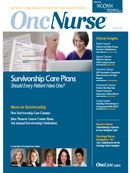Chemotherapy Exposure: Is Your Workplace Safe?
Study finds 17% of oncology nurses in outpatient infusion clinic are exposed to chemotherapy drugs.
Lisa Schulmeister, RN, MN, APRN-BC, OCN®, FAAN
Editor-in-Chief OncLive Nursing
Oncology Nursing Consultant, Adjunct Assistant Professor of Nursing Louisiana State Health Sciences Center in New Orleans, Louisiana
Christopher R. Friese, PhD, RN, AOCN®, assistant professor, University of Michigan School of Nursing, has had a long-standing interest in extending his research on quality of cancer care to the community, where an estimated 85% of cancer care is delivered. He and his research team began by conducting focus groups with staff nurses and learned that many outpatient oncology practices did not have consistent processes in place to keep nurses safe, and that nurses were at risk for unintentional chemotherapy exposure. To learn more about this risk, Friese sought input from a nursing expert in safe handling of hazardous drugs, Martha Polovich, PhD, RN, AOCN®, associate director of Clinical Practice, Duke Oncology Network, and conducted a study to identify the organizational structures and processes of care that are associated with an increased risk of unintentional chemotherapy exposure.
Friese’s research team sent a survey to 1339 outpatient oncology nurses in one state and received 402 responses (response rate, 30.5%). There were minimal demographic differences between respondents and nonrespondents, and 16.9% of the respondents reported that their skin or eyes had been unintentionally exposed to chemotherapy in the previous year. The likelihood of exposure decreased when nurses reported adequate staffing levels and resources, and when they reported that chemotherapy doses were verified by 2 nurses either frequently or very frequently.
When asked if the study findings surprised him, Friese said, “We anticipated that unintentional exposure occurred, but the rate of reported exposure was higher than we thought. Sadly, the reported rate of 17% is consistent with a finding from a study published in the 1980s. We also were surprised how strong the relationship between nursing workloads and exposure was.”
Polovich was also surprised by the reported skin or eye exposure. “Given that nurses are inclined to underestimate their hazardous drug exposure, it is very concerning. Since no information was collected about precaution use, it’s not possible to determine the cause(s) of the exposure. The adverse effects of exposure make this a serious issue.”
Friese has launched a second study to better understand when, where, and why exposure occurs, and what personal protective equipment (PPE) elements and precautions were in place at the time. “This will help us identify the ‘danger zones’ to nurses. Another intriguing area is how clinicians are handling patient excreta. The direct effect of exposure to patient waste is unclear but is ripe for research,” he noted.
The influence of staffing on chemotherapy exposure in Friese’s study is similar to what Polovich found in her soon-to-be published study on precaution use: As the number of patients per day increased, the use of precautions decreased. “Certainly, lower precaution use can result in increased exposure,” she noted. “Since the nurse-patient ratio seems to be related to worker safety as well as patient safety, we need to determine what is the most appropriate staffing for nurses administering chemotherapy. We need to develop and validate acuity systems for outpatient infusion centers. For inpatient chemotherapy, nurses need to have assignments adjusted or be relieved of other patient care when they are responsible for chemotherapy administration. No nurse should be too busy to use safe handling precautions. Managers of chemotherapy nurses have to understand that and plan for it.”
“
Sadly, the reported rate of 17% is consistent with a finding from a study published in the 1980s. We also were surprised how strong the relationship between nursing workloads and exposure was. ”
—Christopher R. Friese, PhD, RN, AOCN®
Polovich also noted that an interesting finding of Friese’s study is that chemotherapy exposure was less likely to occur in organizations where nurses perform a double-check before chemotherapy administration. “It’s not just ‘slowing down’ the process, as some have suggested. To me, it represents the influence of the safety culture in the facility. Organizations with a better safety climate do not separate patient safety from staff safety—they value both. In my study, a positive workplace safety climate was related to higher hazardous drug precaution use. Employers share the responsibility for safe practices, whether it’s adherence to the ASCO/ONS Chemotherapy Safety Standards or the NIOSH, OSHA, or ONS hazardous drugs safe-handling guidelines.”
Friese hopes that his study helps nurses articulate health and safety risks to their employers, and that oncology nurses lead the way in standardizing the process by which chemotherapy is prepared, administered, handled, and disposed. He noted that “increased attention to the workplace is likely to not only confer benefits to patients, but to the clinicians who care for them as well.”
Friese CR, Himes-Ferris L, Frasier MN, et al. Structures and processes of care in ambulatory oncology settings and nurse-reported exposure to chemotherapy [published online ahead of print August 16, 2011]. BMJ Qual Saf. doi:10.1136/ bmjqs-2011-000178.

Innovative Program Reduces Nurse Turnover and Fosters Development
Published: September 12th 2024 | Updated: September 12th 2024The US Oncology Network (The Network) has developed one of the most comprehensive programs in the nation to support the professional development and retention of new oncology nurses.


